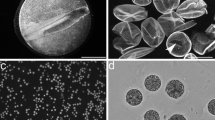Summary
Populations ofPhytophthora palmivora zoospores induced to undergo synchronous differentiation by the addition of pectin showed an ordered sequence of surface changes. Within 10 seconds “blebs” and “microvilli” appeared on the cell and flagellar surfaces. These projections gave the zoospore a highly irregular and even convoluted surface for up to 30 seconds poststimulation. Between 30 and 40 seconds, pits appeared on the surface, which began to assume a smoother texture. Zoospores then rounded up and by 4 minutes had assumed an almost spherical form. At this time the surface became wrinkled as though shrinkage had occurred. Germ tubes could be seen emerging from almost all cells by 40 minutes, and as germ tubes enlarged, the cell surface became smooth again but with a fibrous texture. Many zoospores retained their flagella through to the germling stage.
When cells were stimulated in iso-osmotic rather than hypo-osmotic media, germ tubes in most cases emerged at or very near the site of flagellar attachment. Differentiation in iso-osmotic media showed the same sequence except that the cells did not assume the spherical shape normally characteristic of cysts and germlings differentiating under hypo-osmotic conditions.
Strontium-induced differentiation again followed the same general sequence as desribed above, although the cell surface was noticeably more convoluted and irregular prior to the stage of the formation of pits, and flagella were always shed between 40 seconds and 1 minute. Calcium addition up to 20 seconds after the initiation of differentiation with pectin prevented a high proportion of zoospores from encysting, the cells remained motile, and although the frequency of surface blebs and microvilli increased, pits did not appear.
These surface changes are consistent with those expected during stimulus-mediated secretion, and it appears that calcium is able to inhibit differentiation only before the secretory step (pit formation).
Similar content being viewed by others
References
Antankly T (1984) The cell surface during the secretory process. In: Cell biology of the secretory process. Karger, Basel, pp 171–195
Bacic A., Williams ML, Clarke AE (1985) Studies on the cell surface of zoospores and cysts of the fungusPhytophthora cinnamomi: Nature of the surface saccharides as determined by quantitative lectin binding studies. J Histochem Cytochem 33: 384–388
Barr DJS (1983) The zoosporic grouping of plant pathogens. Entity or non-entity in zoosporic plant pathogens.Buczacki ST (ed) Academic Press, London, pp 43–48
Cerenius L, Olson LW, Lange L, Soderhall K (1984) The secondary zoospore ofAphanomyces astaci andA. caevis (Oomycetes, Saprolegniales). Nordic J Bot 45: 697–706
Desjardins PR.Wang MC, Bartnicki-Garcia S (1973) Electron microscopy of zoospores and cysts ofPhytophthora palmivora: Morphology and surface texture. Arch Microbiol 88: 61–70
Grant BR (1984)Phytophthora cinnamomi a plant pathogen offering possibilities for the biochemist. Trends in Biological Sciences 9: 83–85
—,Griffith JM, Irving HR, Radda M (1984) An improved method for synchronous production of zoospores ofPhytophthora palmivora. Experimental Mycol 8: 382–385
—,Irving HR, Radda M (1985) The effect of pectin and related compounds on encystment and germination ofPhytophthora palmivora zoospores. J Gen Microbiol 131: 382–385
—,Griffith JM, Irving HR (1986) A model to explain ion-induced differentiation in zoospores ofPhytophthora palmivora. Experimental Mycol 10: 89–98
Grove SN, Bracker CE (1978) Protoplasmic changes during zoospore encystment and cyst germination inPythium aphanidermatum. Experimental Mycol 2: 51–98
Hardham AR (1985) Studies on the cell surface of zoospores and cysts of the fungusPhytophthora cinnamomi. The influence of fixation patterns on lectin binding. J Histochem Cytochem 33: 110–118
Hemmes DE (1983) Cytology ofPhytophthora. In:Erwin DC, Bartnicki-Garcia S, Tsao PH (eds)Phytophthora: Its biology, taxonomy, ecology and pathology. Amer Phytopathology Soc, St. Paul. Minnesota. pp 9–40
—,Hohl HR (1971) Ultrastructural aspects of encystment and cystgermination inPhytophthora parasitica. J Cell Sci 9: 175–191
Hinch JM.Wetherbee R.Mallet SE, Clarke AE (1985) Response ofZea mays roots to infection withPhytophthora cinnamomi. 1. The epidermal layer. Protoplasma 126: 178–188
Ho HH, Hickman CJ, Telford RW (1968) The morphology of zoospores ofPhytophthora megasperma var.sojae. Can J Bot 46: 37–41
Irving HR, Griffith JM, Grant BR (1984) Calcium efflux associated with encystment ofPhytophthora palmivora zoospores. Cell Calcium 5: 487–500
Mehrotra RS (1970) Techniques for demonstrating accumulation of zoospores ofPhytophthora species on roots in soil. Can J Bot 48: 879–882
Nogueira MLB, Pinto da Silva P, Bartnicki-Garcia S (1977) Freeze fracture and freeze etching study of encystment ofPhytophthora palmivora zoospores. J Gen Microbiol 1024: 149–155
Pinto da Silva P, Nogueira ML (1977) Membrane fusion during secretion. A hypothesis based on electron microscope observation ofPhytophthora palmivora zoospores during encystment. J Cell Biol 73: 161–181
Reichle RE (1969) Fine structure ofPhytophthora parasitica zoospores. Mycologia 61: 30–51
Sing VO, Bartnicki-Garcia S (1975 a) Adhesion ofPhytophthora palmivora zoospores. Electron microscopy of cell attachment and cyst wall fibril formation. J Cell Sci 18: 123–132
— — (1975 b) Adhesion ofPhytophthora palmivora zoospores. Ultrastructural visualization of concanavalin A receptor sites appearing during encystment. J Cell Sci 19: 11–20
Snell WJ (1984) The role of cilia and flagella in cell interactions. J Protozoology 31: 12–16
Tokunaga J, Bartnicki-Garcia S (1971) Cyst wall formation and endogenous carbohydrate utilization during synchronous encystment ofPhytophthora palmivora zoospores. Arch Mikrobiol 79: 283–292
Zentmyer GA (1970) Tactic responses of zoospores ofPhytophthora. In:Tousson TA, Bega RV, Nelson PE (eds) Root diseases and soil-borne pathogens. U. California Press, Berkeley. pp. 109–111
Zimmerberg J, Cohen FS, Finkelstein M (1980) Fusion of phospholipid vesicles with planar phospholipid bilayer membranes II. Incorporation of a vesicular membrane marker into the planar membrane. J Gen Physiol 75: 251–270
—,Whitaker M (1985) Irreversible swelling of secretory granules during exocytosis caused by calcium. Nature 315: 581–584
Author information
Authors and Affiliations
Rights and permissions
About this article
Cite this article
Paktitis, S., Grant, B. & Lawrie, A. Surface changes inPhytophthora palmivora zoospores following induced differentiation. Protoplasma 135, 119–129 (1986). https://doi.org/10.1007/BF01277005
Received:
Accepted:
Issue Date:
DOI: https://doi.org/10.1007/BF01277005




